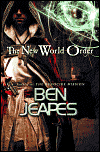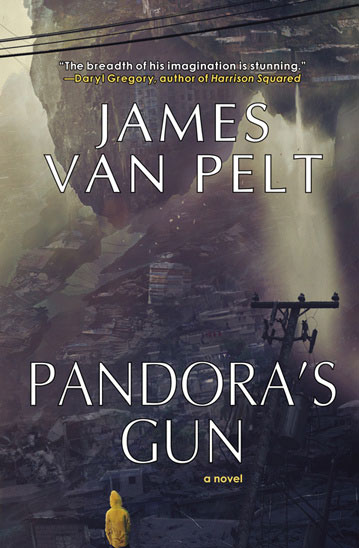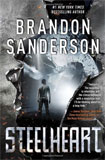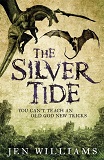Space Cadet, by Robert Heinlein
Book Review by Steve Davidson
Have you read this book?
Space Cadet was Robert Heinlein's third published novel and the second in the annual series of juvenile novels he contracted with Scribners to produce following his short-lived vacation from writing. Letters to John W. Campbell - editor of "Astounding Stories" and Heinlein's discoverer and champion - reveal that the author was getting tired of the limitations imposed on him by writing for the pulps, and getting tired of the relatively poor word rates as well. He announced his intentions to chuck the whole thing, and then shortly thereafter began selling into upscale markets such as the Saturday Evening Post.
His new found literary success led to a contract with Scribners, publishers who were seeking to take advantage of the burgeoning interest in both science fiction and the youth fiction market and a wonderful relationship that would last for some eleven years and eleven novels was established. (The twelfth and final novel of the contract would be rejected as too controversial. It would eventually be published as Starship Troopers.)
By the time Space Cadet was written, Heinlein seems to have settled in on his basic formula, already honed in the run-away success that was "Rocketship Galileo" (few today can appreciate the resonance that a novel featuring secret Nazi bases on the moon would have had in 1947. A contemporary novel featuring the discovery of a secret Al Qaeda space station orbiting the Earth would not even come close). The formula, which is anything but formulaic, features a trio of teenaged pals - budding scientists and engineers each and every one - who are mentored by a wiser, more experienced but equally geeky sage - as they engage in the kind of adventures (for real) that most teenagers only dream of.
In "Rocketship Galileo," the main adventure is building a spaceship that can successfully travel to the moon. In Space Cadet, the clock is spun forward a few decades to a time when space travel is commonplace. Ships and the men who crew them have become the peacekeepers of the solar system; the members of the Interplanetary Patrol, an extra-national UN-based organization, not only patrol the space lanes like a vacuum-borne coast guard, they also control and monitor - and deploy if necessary - the orbiting atomic bomb satellite platforms that keep the nations of Earth at peace.
Matt Dodson is the ordinary American son who gets accepted to the Academy (the year is 2075, still comfortably far enough in the future to remain on the edge of the possible). On his way to Academy headquarters in Colorado Springs, he hooks up with Tex Jarman, a boisterous Texan, and two cadets from the colonies, Oscar Jensen from Venus and Pierre Armand from Ganymede. All three provide color and an opportunity for Heinlein to show us little tidbits of a fully colonized and inhabited solar system.
Later, we meet Girard Burke, Matt's first roommate at the Academy, who serves as the stereotypical blockheaded, insensitive, privileged-son foil to Matt's industrious level-headedness. Burke quickly quits the Academy (he's too good for it). His reappearance later in the story provides Heinlein with a perfect opportunity to illustrate that money and privilege are no substitute for hard work and common sense - traits that the remaining cadets, including Matt, have drilled into them during their stay at the Academy.
During the first half of the story we are taken along as Matt and his fellows learn about the special history of the Patrol, starting with their visit to the rotunda of Hayworth Hall, built around a replica of the crash landing site of the USSF Kilroy Was Here - the first interplanetary ship. Spaced around the hall are four alcoves, each featuring a member of the Patrol who gave their lives to insure the peace and uphold the responsibilities and ideals of the organization: Ezra Dahlquist - died of radiation poisoning while preventing a coup, Rivera - killed while negotiating in his home country's capital, Wheeler and John Martin. These men's names are included in every mustering of the Patrol as an example of the traditions the new cadets are expected to uphold.
Training resembles any boot camp and service academy, from physical inspections to tests that make no sense, all related in an engaging and somewhat humorous manner. Heinlein was a Naval officer and more than familiar with such an environment.
Eventually the cadets are shipped out for their training cruises and enter an entirely new phase of their education, which includes some very realistic illustrations of life in the weightlessness of space. Of special note is the session during which the cadets learn to use their reaction jets to maneuver in space. The suits are equipped with an extendable iron ring site, a practical, non-electronic, virtually infallible device that might very well have been used had space been seriously exploited prior to the advent of microprocessors.
Prior to his first assignment following graduation, Matt takes leave and visits home, where he learns that he's grown up without even realizing it. His brief conversations with his father also illustrate that he's become a member of the Patrol, rather than the citizen of any one particular country.
Finally, in the second half of the novel, Matt begins his career and gains his opportunity to demonstrate that he has earned the right to be called a Cadet. Crash landing on Venus during a routine patrol, Matt, Tex and Oscar apply everything they've learned, stick to the ideals they've been taught and manage to make an unbelievable discovery, while protecting a greedy Earthman from the wrath of the Venusian natives at the same time.
Space Cadet served as the inspiration for one of televisions' earliest feature shows -- "Tom Corbett: Space Cadet" and has no doubt also served as the introduction to good, solid science fiction fare for thousands of readers during the sixty years it has remained in print.
Written for a juvenile audience, the book bears the hallmark of all the Heinlein 'juvenovels' - straightforward and appropriate for a younger reader, engaging, witty and inspiring enough for an adult.
Space Cadet is a quick read, a must read for Heinlein fans and a good read for anyone interested in a novel that is arguably one of the seminal works of the genre.
His new found literary success led to a contract with Scribners, publishers who were seeking to take advantage of the burgeoning interest in both science fiction and the youth fiction market and a wonderful relationship that would last for some eleven years and eleven novels was established. (The twelfth and final novel of the contract would be rejected as too controversial. It would eventually be published as Starship Troopers.)
By the time Space Cadet was written, Heinlein seems to have settled in on his basic formula, already honed in the run-away success that was "Rocketship Galileo" (few today can appreciate the resonance that a novel featuring secret Nazi bases on the moon would have had in 1947. A contemporary novel featuring the discovery of a secret Al Qaeda space station orbiting the Earth would not even come close). The formula, which is anything but formulaic, features a trio of teenaged pals - budding scientists and engineers each and every one - who are mentored by a wiser, more experienced but equally geeky sage - as they engage in the kind of adventures (for real) that most teenagers only dream of.
In "Rocketship Galileo," the main adventure is building a spaceship that can successfully travel to the moon. In Space Cadet, the clock is spun forward a few decades to a time when space travel is commonplace. Ships and the men who crew them have become the peacekeepers of the solar system; the members of the Interplanetary Patrol, an extra-national UN-based organization, not only patrol the space lanes like a vacuum-borne coast guard, they also control and monitor - and deploy if necessary - the orbiting atomic bomb satellite platforms that keep the nations of Earth at peace.
Matt Dodson is the ordinary American son who gets accepted to the Academy (the year is 2075, still comfortably far enough in the future to remain on the edge of the possible). On his way to Academy headquarters in Colorado Springs, he hooks up with Tex Jarman, a boisterous Texan, and two cadets from the colonies, Oscar Jensen from Venus and Pierre Armand from Ganymede. All three provide color and an opportunity for Heinlein to show us little tidbits of a fully colonized and inhabited solar system.
Later, we meet Girard Burke, Matt's first roommate at the Academy, who serves as the stereotypical blockheaded, insensitive, privileged-son foil to Matt's industrious level-headedness. Burke quickly quits the Academy (he's too good for it). His reappearance later in the story provides Heinlein with a perfect opportunity to illustrate that money and privilege are no substitute for hard work and common sense - traits that the remaining cadets, including Matt, have drilled into them during their stay at the Academy.
During the first half of the story we are taken along as Matt and his fellows learn about the special history of the Patrol, starting with their visit to the rotunda of Hayworth Hall, built around a replica of the crash landing site of the USSF Kilroy Was Here - the first interplanetary ship. Spaced around the hall are four alcoves, each featuring a member of the Patrol who gave their lives to insure the peace and uphold the responsibilities and ideals of the organization: Ezra Dahlquist - died of radiation poisoning while preventing a coup, Rivera - killed while negotiating in his home country's capital, Wheeler and John Martin. These men's names are included in every mustering of the Patrol as an example of the traditions the new cadets are expected to uphold.
Training resembles any boot camp and service academy, from physical inspections to tests that make no sense, all related in an engaging and somewhat humorous manner. Heinlein was a Naval officer and more than familiar with such an environment.
Eventually the cadets are shipped out for their training cruises and enter an entirely new phase of their education, which includes some very realistic illustrations of life in the weightlessness of space. Of special note is the session during which the cadets learn to use their reaction jets to maneuver in space. The suits are equipped with an extendable iron ring site, a practical, non-electronic, virtually infallible device that might very well have been used had space been seriously exploited prior to the advent of microprocessors.
Prior to his first assignment following graduation, Matt takes leave and visits home, where he learns that he's grown up without even realizing it. His brief conversations with his father also illustrate that he's become a member of the Patrol, rather than the citizen of any one particular country.
Finally, in the second half of the novel, Matt begins his career and gains his opportunity to demonstrate that he has earned the right to be called a Cadet. Crash landing on Venus during a routine patrol, Matt, Tex and Oscar apply everything they've learned, stick to the ideals they've been taught and manage to make an unbelievable discovery, while protecting a greedy Earthman from the wrath of the Venusian natives at the same time.
Space Cadet served as the inspiration for one of televisions' earliest feature shows -- "Tom Corbett: Space Cadet" and has no doubt also served as the introduction to good, solid science fiction fare for thousands of readers during the sixty years it has remained in print.
Written for a juvenile audience, the book bears the hallmark of all the Heinlein 'juvenovels' - straightforward and appropriate for a younger reader, engaging, witty and inspiring enough for an adult.
Space Cadet is a quick read, a must read for Heinlein fans and a good read for anyone interested in a novel that is arguably one of the seminal works of the genre.
|
Click here to buy Space Cadet, by Robert Heinlein on Amazon
|
Space Cadet, by Robert Heinlein on Amazon
| More Books You Might Like |
Comment on Space Cadet, by Robert Heinlein
| Comments on Space Cadet, by Robert Heinlein |
| There are no comments on this book. |



